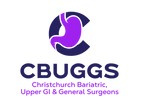Canterbury > Private Hospitals & Specialists >
Christchurch Bariatric, Upper GI & General Surgeons (CBUGGS)
Private Service, Bariatric (Weight Loss) Surgery, General Surgery
Today
8:00 AM to 5:00 PM.
Description
Christchurch Bariatric, Upper GI & General Surgeons (CBUGGS) comprises two surgeons and a support team who are dedicated to helping patients improve their health and quality of life. We specialise in weight loss (bariatric) surgery, upper gastrointestinal and general surgery & endoscopy.
We offer you:
- Pre-screening and consultation to establish a personalised plan
- Clear explanations and an informed consent process
- Guidance and lifestyle support to ensure positive surgical results remain longstanding
What is Bariatric Surgery?
Bariatric or weight loss surgery is a term that covers all the different surgical procedures used to help extremely overweight or morbidly obese patients lose weight.
Morbidly obese patients are usually identified by their Body Mass Index (BMI) measurement, although other factors may also be taken into account. Morbid obesity is associated with an increased risk of developing illnesses such as: heart attack, hypertension, stroke, diabetes, sleep disorders and joint pain. Bariatric surgery can cure or greatly improve these illnesses as well as give the patient an improved quality of life.
What is Upper GI Surgery?
Upper gastrointestinal procedures (both laparoscopic and open) are able to treat conditions ranging from acid reflux to benign and cancerous conditions of the oesophagus, stomach, small and large intestine. In addition, we are experienced in managing gallbladder, bile duct, liver and pancreas disorders with particular expertise in all gallstone pathology.
What is General Surgery?
The role of the general surgeon varies, but in broad terms general surgery can be said to deal with a wide range of conditions within the abdomen, breast, neck, skin and, sometimes, vascular (blood vessel) system.
While the name would suggest that the focus of general surgery is to perform operations, often this is not the case. Many patients are referred to surgeons with conditions that do not need surgical procedures, but merely require counselling or medical treatment.
Staff
Michelle Allan: Dietitian - specialising in bariatric surgery, Michelle ensures patients are well supported and educated throughout their weight loss journey. Read more about Michelle here
Consultants
-

Mr Matthew Leeman
Surgeon
-

Mr Rukshan Ranjan
Surgeon
Ages
Adult / Pakeke, Older adult / Kaumātua
How do I access this service?
Referral
Anyone can access
We welcome patient self referral and enquiries
Referral Expectations
When you come to your appointment, your surgeon will ask questions about your illness and examine you to try to determine or confirm the diagnosis. This process may also require a number of tests (e.g. blood tests, x-rays, scans etc). Sometimes this can all be done during one visit, but for some conditions this will take several follow-up appointments. Occasionally some tests are arranged even before your appointment to try to speed up the process.
Once a diagnosis has been made, your surgeon will discuss treatment with you. In some instances this will mean surgery, while other cases can be managed with medication and advice. If surgery is advised, the steps involved in the surgical process and the likely outcome are usually discussed with you at this time.
Fees and Charges Categorisation
Fees apply
Fees and Charges Description
There may be health insurance cover for patients with nib and Southern Cross. Please consult your insurer.
Hours
8:00 AM to 5:00 PM.
| Mon – Fri | 8:00 AM – 5:00 PM |
|---|
Languages Spoken
English
Procedures / Treatments
Bariatric or weight loss surgery refers to a number of different procedures that can be performed to treat obesity. Procedures fall into three main types: Malabsorptive - these procedures involve bypassing a section of the small intestine thus reducing the amount of food absorbed into the body. Restrictive - these procedures involve reducing the size of the stomach, usually by creating a small pouch at the top of the stomach which limits the amount of food that can be eaten. Malabsorptive/Restrictive Combination - these procedures combine both techniques e.g. gastric bypass surgery in which a small stomach pouch is formed and its outlet connected to part of the small intestine.
Bariatric or weight loss surgery refers to a number of different procedures that can be performed to treat obesity. Procedures fall into three main types: Malabsorptive - these procedures involve bypassing a section of the small intestine thus reducing the amount of food absorbed into the body. Restrictive - these procedures involve reducing the size of the stomach, usually by creating a small pouch at the top of the stomach which limits the amount of food that can be eaten. Malabsorptive/Restrictive Combination - these procedures combine both techniques e.g. gastric bypass surgery in which a small stomach pouch is formed and its outlet connected to part of the small intestine.
Bariatric or weight loss surgery refers to a number of different procedures that can be performed to treat obesity. Procedures fall into three main types:
Malabsorptive - these procedures involve bypassing a section of the small intestine thus reducing the amount of food absorbed into the body.
Restrictive - these procedures involve reducing the size of the stomach, usually by creating a small pouch at the top of the stomach which limits the amount of food that can be eaten.
Malabsorptive/Restrictive Combination - these procedures combine both techniques e.g. gastric bypass surgery in which a small stomach pouch is formed and its outlet connected to part of the small intestine.
This is a procedure which allows the doctor to see inside your oesophagus, stomach, and the first part of the small intestine (duodenum) and examine the lining directly. What to expect The gastroscope is a plastic-coated tube about as thick as a ballpoint pen and is flexible. It has a tiny camera attached that sends images to a viewing screen. During the test you will swallow the tube but the back of your throat is sprayed with anaesthetic so you don’t feel this. You will be offered a sedative (medicine that will make you sleepy but is not a general anaesthetic) as well. If the doctor sees any abnormalities they can take a biopsy (a small piece of tissue) to send to the laboratory for testing. This is not a painful procedure and will be performed at the day stay unit in a theatre suite (operating room) by a specialist doctor with nurses assisting. Complications from this procedure are very rare but can occur. They include: bleeding after a biopsy, if performed an allergic reaction to the sedative or throat spray perforation (tearing) of the stomach with the instrument (this is a serious but extremely rare complication). Before the procedure You will be asked not to eat anything from midnight the night before and not to take any of your medications on the day of the procedure. After the procedure You will stay in the day stay unit until the sedation has worn off which usually takes 1-2 hours. You will be given something to eat or drink before you go home. If you have been sedated, you are not to drive until the following day. If biopsies are taken these will be sent for analysis and results are available within 2-3 weeks. A report and copies of these are sent to your GP.
This is a procedure which allows the doctor to see inside your oesophagus, stomach, and the first part of the small intestine (duodenum) and examine the lining directly. What to expect The gastroscope is a plastic-coated tube about as thick as a ballpoint pen and is flexible. It has a tiny camera attached that sends images to a viewing screen. During the test you will swallow the tube but the back of your throat is sprayed with anaesthetic so you don’t feel this. You will be offered a sedative (medicine that will make you sleepy but is not a general anaesthetic) as well. If the doctor sees any abnormalities they can take a biopsy (a small piece of tissue) to send to the laboratory for testing. This is not a painful procedure and will be performed at the day stay unit in a theatre suite (operating room) by a specialist doctor with nurses assisting. Complications from this procedure are very rare but can occur. They include: bleeding after a biopsy, if performed an allergic reaction to the sedative or throat spray perforation (tearing) of the stomach with the instrument (this is a serious but extremely rare complication). Before the procedure You will be asked not to eat anything from midnight the night before and not to take any of your medications on the day of the procedure. After the procedure You will stay in the day stay unit until the sedation has worn off which usually takes 1-2 hours. You will be given something to eat or drink before you go home. If you have been sedated, you are not to drive until the following day. If biopsies are taken these will be sent for analysis and results are available within 2-3 weeks. A report and copies of these are sent to your GP.
This is a procedure which allows the doctor to see inside your oesophagus, stomach, and the first part of the small intestine (duodenum) and examine the lining directly.
What to expect
The gastroscope is a plastic-coated tube about as thick as a ballpoint pen and is flexible. It has a tiny camera attached that sends images to a viewing screen. During the test you will swallow the tube but the back of your throat is sprayed with anaesthetic so you don’t feel this. You will be offered a sedative (medicine that will make you sleepy but is not a general anaesthetic) as well. If the doctor sees any abnormalities they can take a biopsy (a small piece of tissue) to send to the laboratory for testing.
This is not a painful procedure and will be performed at the day stay unit in a theatre suite (operating room) by a specialist doctor with nurses assisting.
Complications from this procedure are very rare but can occur. They include:
- bleeding after a biopsy, if performed
- an allergic reaction to the sedative or throat spray
- perforation (tearing) of the stomach with the instrument (this is a serious but extremely rare complication).
Before the procedure
You will be asked not to eat anything from midnight the night before and not to take any of your medications on the day of the procedure.
After the procedure
You will stay in the day stay unit until the sedation has worn off which usually takes 1-2 hours. You will be given something to eat or drink before you go home. If you have been sedated, you are not to drive until the following day.
If biopsies are taken these will be sent for analysis and results are available within 2-3 weeks. A report and copies of these are sent to your GP.
This is a procedure which allows the doctor to see inside your large bowel and examine the surfaces directly and take biopsies (samples of tissue) if needed. Treatment of conditions can also be undertaken. What to expect The colonoscope is a flexible plastic-coated tube a little thicker than a ballpoint pen which has a tiny camera attached that sends images to a viewing screen. You will be given a sedative (medicine that will make you sleepy but is not a general anaesthetic). The tube is passed into the rectum (bottom) and gently moved along the large bowel. The procedure takes from 10 minutes to 1 hour and your oxygen levels and heart rhythm are monitored throughout. The procedure is performed in a day stay operating theatre. Before the procedure You will need to follow a special diet and take some laxatives (medicine to make you go to the toilet) over the days leading up to the test. Risks of a colonoscopy are rare but include: bleeding if a biopsy is performed allergic reaction to the sedative perforation (tearing) of the bowel wall.
This is a procedure which allows the doctor to see inside your large bowel and examine the surfaces directly and take biopsies (samples of tissue) if needed. Treatment of conditions can also be undertaken. What to expect The colonoscope is a flexible plastic-coated tube a little thicker than a ballpoint pen which has a tiny camera attached that sends images to a viewing screen. You will be given a sedative (medicine that will make you sleepy but is not a general anaesthetic). The tube is passed into the rectum (bottom) and gently moved along the large bowel. The procedure takes from 10 minutes to 1 hour and your oxygen levels and heart rhythm are monitored throughout. The procedure is performed in a day stay operating theatre. Before the procedure You will need to follow a special diet and take some laxatives (medicine to make you go to the toilet) over the days leading up to the test. Risks of a colonoscopy are rare but include: bleeding if a biopsy is performed allergic reaction to the sedative perforation (tearing) of the bowel wall.
This is a procedure which allows the doctor to see inside your large bowel and examine the surfaces directly and take biopsies (samples of tissue) if needed. Treatment of conditions can also be undertaken.
What to expect
The colonoscope is a flexible plastic-coated tube a little thicker than a ballpoint pen which has a tiny camera attached that sends images to a viewing screen. You will be given a sedative (medicine that will make you sleepy but is not a general anaesthetic). The tube is passed into the rectum (bottom) and gently moved along the large bowel. The procedure takes from 10 minutes to 1 hour and your oxygen levels and heart rhythm are monitored throughout.
The procedure is performed in a day stay operating theatre.
Before the procedure
You will need to follow a special diet and take some laxatives (medicine to make you go to the toilet) over the days leading up to the test.
Risks of a colonoscopy are rare but include:
- bleeding if a biopsy is performed
- allergic reaction to the sedative
- perforation (tearing) of the bowel wall.
ENDOSCOPIC RETROGRADE CHOLANGIO PANCREATOGRAPHY (ERCP) A flexible tube with a video camera (endoscope) is inserted through the mouth into the stomach and small intestine while you are under sedation. A smaller tube is then advanced through the first tube into the bile duct (the tube that connects your gallbladder to your intestines) through which dye is injected and an x-ray is taken to visualise the tubes. This procedure also allows the extraction of stones from the tubes without the need for surgery. The risks and procedure are similar to gastroscopy and colonoscopy.
ENDOSCOPIC RETROGRADE CHOLANGIO PANCREATOGRAPHY (ERCP) A flexible tube with a video camera (endoscope) is inserted through the mouth into the stomach and small intestine while you are under sedation. A smaller tube is then advanced through the first tube into the bile duct (the tube that connects your gallbladder to your intestines) through which dye is injected and an x-ray is taken to visualise the tubes. This procedure also allows the extraction of stones from the tubes without the need for surgery. The risks and procedure are similar to gastroscopy and colonoscopy.
ENDOSCOPIC RETROGRADE CHOLANGIO PANCREATOGRAPHY (ERCP)
A flexible tube with a video camera (endoscope) is inserted through the mouth into the stomach and small intestine while you are under sedation. A smaller tube is then advanced through the first tube into the bile duct (the tube that connects your gallbladder to your intestines) through which dye is injected and an x-ray is taken to visualise the tubes. This procedure also allows the extraction of stones from the tubes without the need for surgery.
The risks and procedure are similar to gastroscopy and colonoscopy.
Sometimes, some of the watery fluid (bile) stored in the gallbladder hardens into pieces of stone-like material known as gallstones. Gallstones may vary from the size of a grain of sand to a golf ball and there may be one or hundreds of stones. Gallstones can cause abdominal pain, fever and vomiting if they block the movement of bile into or out of the gallbladder. Laparoscopic Cholecystectomy is the surgical removal of the gallbladder. A laparoscope is inserted into the abdominal cavity at the level of the tummy button. Surgical instruments are inserted through other incisions and the gallbladder removed.
Sometimes, some of the watery fluid (bile) stored in the gallbladder hardens into pieces of stone-like material known as gallstones. Gallstones may vary from the size of a grain of sand to a golf ball and there may be one or hundreds of stones. Gallstones can cause abdominal pain, fever and vomiting if they block the movement of bile into or out of the gallbladder. Laparoscopic Cholecystectomy is the surgical removal of the gallbladder. A laparoscope is inserted into the abdominal cavity at the level of the tummy button. Surgical instruments are inserted through other incisions and the gallbladder removed.
Gallstones can cause abdominal pain, fever and vomiting if they block the movement of bile into or out of the gallbladder.
Laparoscopic Cholecystectomy is the surgical removal of the gallbladder. A laparoscope is inserted into the abdominal cavity at the level of the tummy button. Surgical instruments are inserted through other incisions and the gallbladder removed.
A hernia exists where part of the abdominal wall is weakened and the contents of the abdomen push through to the outside. An inguinal hernia forms when part of the intestine pushes through the abdominal wall, causing a bulge in the groin. A hiatus hernia is caused by part of the stomach and lower oesophagus bulging through the diaphragm (a sheet of muscle between the chest and the stomach) into the chest. A hiatus hernia can cause a burning feeling in the upper abdomen and chest (heartburn). Laparoscopic Hernia Repair involves using surgical instruments to push the hernia back into its original position and repairing the weakness in the abdominal wall (or diaphragm in the case of a hiatus hernia).
A hernia exists where part of the abdominal wall is weakened and the contents of the abdomen push through to the outside. An inguinal hernia forms when part of the intestine pushes through the abdominal wall, causing a bulge in the groin. A hiatus hernia is caused by part of the stomach and lower oesophagus bulging through the diaphragm (a sheet of muscle between the chest and the stomach) into the chest. A hiatus hernia can cause a burning feeling in the upper abdomen and chest (heartburn). Laparoscopic Hernia Repair involves using surgical instruments to push the hernia back into its original position and repairing the weakness in the abdominal wall (or diaphragm in the case of a hiatus hernia).
A hernia exists where part of the abdominal wall is weakened and the contents of the abdomen push through to the outside.
An inguinal hernia forms when part of the intestine pushes through the abdominal wall, causing a bulge in the groin.
A hiatus hernia is caused by part of the stomach and lower oesophagus bulging through the diaphragm (a sheet of muscle between the chest and the stomach) into the chest. A hiatus hernia can cause a burning feeling in the upper abdomen and chest (heartburn).
Laparoscopic Hernia Repair involves using surgical instruments to push the hernia back into its original position and repairing the weakness in the abdominal wall (or diaphragm in the case of a hiatus hernia).
GORD is caused by the backflow (reflux) of food and stomach acid into the oesophagus (the tube that connects the mouth to the stomach) from the stomach. This happens when the valve between the stomach and the lower end of the oesophagus is not working properly. The main symptom of GORD is heartburn (a burning feeling in the stomach and chest). Laparoscopic Nissen Fundiplication is a surgical procedure for GERD that involves wrapping the top part of the stomach (fundus) around the lower end of the oesophagus. The valve between the stomach and the oesophagus is also replaced or repaired.
GORD is caused by the backflow (reflux) of food and stomach acid into the oesophagus (the tube that connects the mouth to the stomach) from the stomach. This happens when the valve between the stomach and the lower end of the oesophagus is not working properly. The main symptom of GORD is heartburn (a burning feeling in the stomach and chest). Laparoscopic Nissen Fundiplication is a surgical procedure for GERD that involves wrapping the top part of the stomach (fundus) around the lower end of the oesophagus. The valve between the stomach and the oesophagus is also replaced or repaired.
Laparoscopic Nissen Fundiplication is a surgical procedure for GERD that involves wrapping the top part of the stomach (fundus) around the lower end of the oesophagus. The valve between the stomach and the oesophagus is also replaced or repaired.
The appendix is a small worm-like tube attached to the intestine in the lower right abdomen. If it becomes blocked or infected it can cause appendicitis, which is recognised by pain on the right side of the abdomen, nausea and vomiting. Laparoscopic Appendicectomy is the removal of the appendix using surgical instruments inserted through incisions in the lower right abdomen.
The appendix is a small worm-like tube attached to the intestine in the lower right abdomen. If it becomes blocked or infected it can cause appendicitis, which is recognised by pain on the right side of the abdomen, nausea and vomiting. Laparoscopic Appendicectomy is the removal of the appendix using surgical instruments inserted through incisions in the lower right abdomen.
The appendix is a small worm-like tube attached to the intestine in the lower right abdomen. If it becomes blocked or infected it can cause appendicitis, which is recognised by pain on the right side of the abdomen, nausea and vomiting.
Laparoscopic Appendicectomy is the removal of the appendix using surgical instruments inserted through incisions in the lower right abdomen.
The best way to establish what type of liver disease is present and the extent of the disease, is a biopsy. It is usually performed by inserting a needle into the liver through the skin and taking a small sample of liver tissue. Examination of the sample under the microscope can demonstrate what damage or what type of disease is present. Before your doctor does this procedure, they will check whether or not you are at increased risk of bleeding by doing blood tests. Following the procedure, you will need to be monitored for several hours before you are discharged to go home.
The best way to establish what type of liver disease is present and the extent of the disease, is a biopsy. It is usually performed by inserting a needle into the liver through the skin and taking a small sample of liver tissue. Examination of the sample under the microscope can demonstrate what damage or what type of disease is present. Before your doctor does this procedure, they will check whether or not you are at increased risk of bleeding by doing blood tests. Following the procedure, you will need to be monitored for several hours before you are discharged to go home.
Disability Assistance
Wheelchair access, Wheelchair accessible toilet, Mobility parking space
Additional Details
Face to face / Kanohi ki te Kanohi, Phone
Parking
Free patient parking is provided
Pharmacy
Find your nearest pharmacy here
Website
Contact Details
8:00 AM to 5:00 PM.
-
Phone
(03) 968 3140
Healthlink EDI
cbuggsch
Email
Website
21 Caledonian Road
Saint Albans
Christchurch
Canterbury 8013
Street Address
21 Caledonian Road
Saint Albans
Christchurch
Canterbury 8013
Was this page helpful?
This page was last updated at 1:12PM on December 10, 2024. This information is reviewed and edited by Christchurch Bariatric, Upper GI & General Surgeons (CBUGGS).

